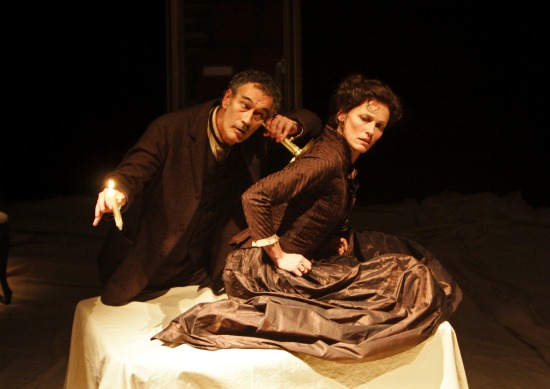
David Krugel and Cora Bos-Kroese in Jirí Kylián and Michael Schumacher's Last Touch First. Photo: Robert Benschop
If this is a summerhouse somewhere in Europe around the end of the 19thcentury, why is the furniture still shrouded in dust sheets and marooned on a rumpled, sheeted floor? This question is not the only one you might ask yourself while watching the inhabitants of the room move in slow motion through 50 or so minutes of a deceptively uneventful day.
Last Touch First (at the Joyce Theater, April 10 through 15) by Jirí Kylián and Michael Schumacher is an expanded version of Last Touch First, created by Kylián in 2003 for Nederlands Dans Theater III, an ensemble of dancers over 40. Because the six remarkable performers in this 2008 piece move at such a glacial pace, sometimes freezing mid-gesture, there’s plenty of time to wonder who they are and what they want in this strange habitat (original design by Walter Nobbe). You may identify Elke Schepers, reading in a rocking chair, as a young wife and Václav Kunes as her just-arrived husband. You can see that the relationship between vulpine David Krugel and Cora Bos-Kroese, severely elegant in a black taffeta gown (costumes by Joke Visser), is ignited by a domineering lust on his part; it burns more hotly than the candle lighting the table where they enact their struggles. Why does Sabine Kupferberg drink alone, and what molds the transactions between her and Schumacher, who may, in his slo-mo card game with Krugel, be cheating?
The languid passage of time calls to mind Chekov’s Three Sisters and The Cherry Orchard, in which inaction is a habit. Irina will never get to Moscow, and inevitably, it will take the sound of an axe hitting a tree trunk to end a family’s leisurely way of life. Watching Last Touch First the way you would watch most plays and dances isn’t possible. Because of the tempo and the subtlety of some of the moves, your focus keeps shifting; changes hover at the edges of your peripheral vision; a surprising sharp action may draw your eyes. You’re constantly sensing that you may have missed something.
Is it possible that you’re seeing inner desires played out in dreams? Some of the acts aren’t ones usually performed in the presence of others, and the pace can make a simple gesture seem sinister. What might be a hearty laugh on Krugel’s part turns him into the villain of a melodrama. And the performers’ actions become increasingly bizarre. Kupferberg throws her white skirt over Schumacher’s head and throttles him with quick jerks. Kunes, who has been as interested in the book as Schepers, suddenly tears out a page and stuffs pieces of it into her mouth. Kunes (who has disappeared for a while under the floor covering, rearing up to form a mountain for Bos-Kroese to climb on) joins Schumacher in balancing on the legs of the inverted table. The two men grapple. Schepers pulls Kunes off and, in suddenly near-darkness lashes him with her skirt and wrestles him on the ground. Something has gone terribly wrong in this relationship.
Dirk Haubrich’s recorded score begins with single low, echoing, piano notes—as insistent as drips of water. Adds higher tones. At times, it sounds a little like one of Satie’s Gymnopédies. Intermittent pings—as if a knife were hitting a glass—cause sudden sharp moves: a turn of the head, a rise. As the events become increasingly surreal, nasty, metallic slashings and twangings erupt in the music. When Krugel takes hold of a large mirror that has been standing at the back and tilts it this way and that, the lighting (by Kees Tjebbes and Ellen Knops) darts dizzyingly around the room. The characters’ behavior—enabled by their dancerly skills—becomes more extravagant. Women climb and tread on men, Kupferberg slowly pushes Schumacher from a sitting position to a standing one by pressing her now-bare feet against his back. Krugel bends Bos-Kroese painfully backward over the table. At different moments, Kupferberg and Schumacher have fits—jerking and twitching; it’s as if frail wires holding each one erect had broken and were snarling together. Yet the increasing number of faster motions never replaces the sluggish, yet intense flow of the piece.
Although much that transpires does so within couples, the six do watch and occasionally react to one another. If the boundary between public and private is porous, that between inside and outside is enigmatic. At one point, Schumacher and Kupferberg seem about to walk out the room’s open door, but he pulls back. At the end, she, carrying the candle, walks toward that exit, then passes it by. While watching her do this, the others drop off the stage and, crouching at the feet of front-row spectators, slowly drag the floor cloth toward them. The rocking chair gradually rotates; the card table and Kupferberg’s armchair move toward the center of the stage. The music dwindles to a low hum. The performers climb back onto the stage, looking at one another as if to ask, “What just happened?” Then they assume the positions they were in at the beginning, but now the space is smaller, and Kunes, who was poised in the doorway almost an hour ago, braces his hand against a jamb of air.
You might think all this slow motion would make for a boring work. It doesn’t. You’re almost too active to be bored—looking here and there, wondering what’s going on with these intriguingly unhappy people, what went on yesterday, what they might mean to one another, and what—if anything—has changed.
The performers—all but Schumacher members of the now-defunct Nederlands Dans Theater III—are extraordinary. They maintain their snail’s pace with uncanny smoothness and precision, which sometimes means sustaining off-balance moments for longer than seems possible or getting into unusual maneuvers without a preparatory jerk. But they are also consummate actors. We may not know the depths of the characters they portray, but they do.
Chekhov also had a hand in David Neumann’s Restless Eye. The “Director’s Note” in the program for his Advanced Beginner Group’s late March premiere at New York Live Arts informs us that “Among many other things, I love the language of lunar missions of the 60s, the world Chekhov creates in a seemingly simple stage direction and making connections between the mundane and the infinite.”
Welcome to the wide-open world of postmodernism where anything can go with anything. Think of today’s far-out chefs. Eel ice cream with shaved peach skin? Not all that improbable. Neumann, a brainy, witty forager in dance theater, layers unlike elements in ways you mightn’t have expected to create a work that might puzzle you in more intricate ways than Schumacher and Kylián’s Last Touch First. Wanting to discover new ways of moving and putting movements together, Neumann turned to “numerical data sets, patterns and processes that elude prediction (such as the flight patterns of bats), and digital animations of sound waves” as source material.
You don’t often happen upon a “suggested reading” list and a “further reading” list in the program for a dance theater event. Their inclusion is daunting, if rather beguiling. Neumann wants to ramp up our brains. I’m not sure that Thomas Kuhn’s The Structure of Scientific Revolutions will help me to understand Restless Eye retrospectively, and it’s not a good idea to feel inadequate when watching a show. After letting us know the intellectual bases for the piece, Neumann has the nerve to say, “Enjoy!”
Of course, he probably knows we will enjoy ourselves, whether or not we can figure out exactly how the weird-looking headgear that some of the performers wear from time to time is triggering Christine Shallenberg’s lighting, and what system generated that result. And we don’t need to understand how data translates into movement, although anyone familiar with Neumann’s previous works can see that this dancing has a different look: less fluid, more straight-lined, frequently paused.
The stage is an intriguing place. Angled at one side sits a small “house” of unpainted wallboard by Gordon Landenberger. Two steps lead up to its arched doorway, and its window wraps around a corner. At the center back of the area, two wrought-iron patio chairs, a wicker armchair, and a tall, wood-backed stool sit on a pale rug. Opposite the house, a baby grand is swathed in plastic wrap, with only its keyboard uncovered. In this environment Andrew Dinwiddie, Kennis Hawkins, Neal Medlyn, Jeremy Olson, and Victoria Roberts-Wierzbowski speak portions of Sybil Kempson’s text in addition to dancing.
Allusions to Chekhov’s The Cherry Orchard, like the line “A distant sound is heard. It appears to come from the sky,” mingle with recorded mission-control voices and birdsong in Tei Blow’s soundscore. And the images—for ears and eyes—often refer to endangered nature and gardens. Several times Medlyn speaks of “mounting dread” and reminds us that “trees feel”—drawing out the “ee” sound. Blow’s ravishing videos turn the tiny house into a grand one, with a great hall and a pillared dining room, and surround it with gardens, Medlyn plays tour guide, referring to a “room still called the nursery.” Roberts-Wierbowski discusses the landscaping. We hear a tree limb breaking.
In the beginning, after Dinwiddie announces that he will read us a sample of his writing and doesn’t exactly, the others gather on the “terrace” and snatch chairs, freeze, assume weird positions on other chairs, then quickly re-arrange the seating (system unknown). There’s a lot to take in: quantities of dancing (hard to take my eyes off tall, gorgeous Kennis Hawkins), old astronomical maps appearing on the house’s walls, recorded voices, performers talking into mics, Medlyn (always a striking performer) hitting notes on the keyboard, references to disasters and deer-hunting, people entering the house, erratically changing lighting. All wedged and slid together with myriad other fragments suggesting changing times, changing galaxies, changing universes.
As with the Kylián-Schumacher piece, you’re left thinking, “What did I just see?” But in the case of Restless Eye, with its ebullient intellectual shattering of cause and effect, you’re not tempted to psychoanalyze the people you see onstage. Instead you absorb and remember what you can, and end up with a bunch of bright fragments jostling together. Perhaps some act as flint to another’s tinder and ignite “meaning.” You aren’t likely to walk out of the theater singing or deeply moved. But stimulated, provoked, entertained? Certainly (if that’s an okay word to use under the circumstances).

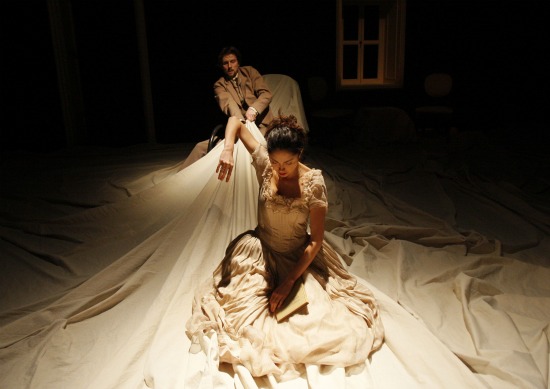
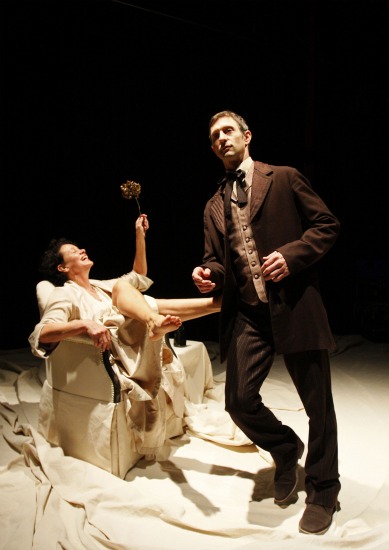
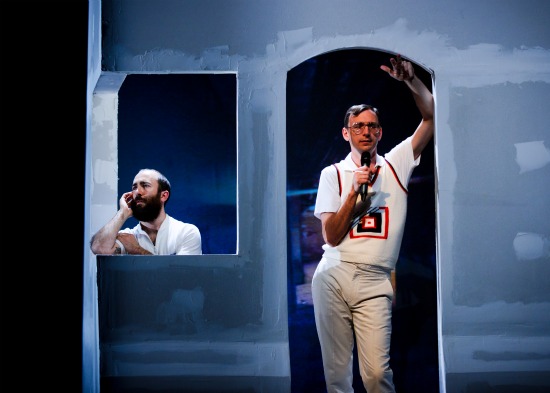
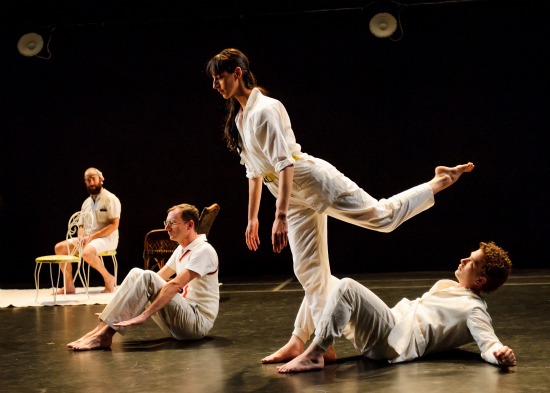
“Eel ice cream with shaved peach skin?”…. In Portland, Oregon, only if the eel had a happy life, and the peach, free of pesticides, was plucked from the tree by members of the United Farmworkers Union. In all seriousness, if “Last Touch First” was half as interesting to watch as Deborah’s review is to read, it’s a masterpiece.
At the talkback for this show on Thursday, Michael Schumacher strongly suggested that–though he didn’t use the word–the Chekhov material was a kind of MacGuffin, that the real game the choreographers were playing was the perceptual enigma Deborah reports. Schumacher estimated that, if the actions for this hour-long production were performed in real time, they’d last about three minutes. Drawn out, one might expect, an observer would be able to take in everything. And yet, paradoxically, one focuses on just one movement, only gradually becoming aware through peripheral vision that other movement processes had been initiated. The key, he explained, was to perform “Last Touch First” in a small theater, where the audience’s proximity to the action created almost a physical bond to the performers. In a large opera house, he noted, one really would be able to take in the entire stage picture, and the work’s reason for being–the drawing-in of the audience to the stage events–would be cancelled out.